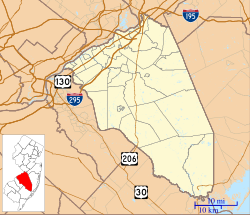
Bordentown is a city in Burlington County, in the U.S. state of New Jersey. As of the 2020 United States census, the city's population was 3,993, an increase of 69 (+1.8%) from the 2010 census count of 3,924, which in turn reflected a decline of 45 (−1.1%) from the 3,969 counted in the 2000 census.

Bordentown Township is a township in Burlington County, in the U.S. state of New Jersey. As of the 2020 United States census, the township's population was 11,791, an increase of 424 (+3.7%) from the 2010 census count of 11,367, which in turn reflected an increase of 2,987 (+35.6%) from the 8,380 counted in the 2000 census. The township, and all of Burlington County, is a part of the Philadelphia-Reading-Camden combined statistical area and the Delaware Valley.

Tuskegee University is a private, historically black land-grant university in Tuskegee, Alabama. It was founded on Independence Day in 1881 by the Alabama Legislature.

Robert Robinson Taylor was an American architect and educator. Taylor was the first African-American student enrolled at the Massachusetts Institute of Technology (MIT), and the first accredited African-American architect when he graduated in 1892. He was an early and influential member of the Tuskegee Institute faculty.

Margaret Murray Washington was an American educator who was the principal of Tuskegee Normal and Industrial Institute, which later became Tuskegee University. She also led women's clubs, including the Tuskegee Woman's Club and the National Federation of Afro-American Women. She was the third wife of Booker T. Washington. She was inducted into the Alabama Women's Hall of Fame in 1972.
Voorhees University is a private historically black university in Denmark, South Carolina. It is affiliated with the Episcopal Church and accredited by the Southern Association of Colleges and Schools.
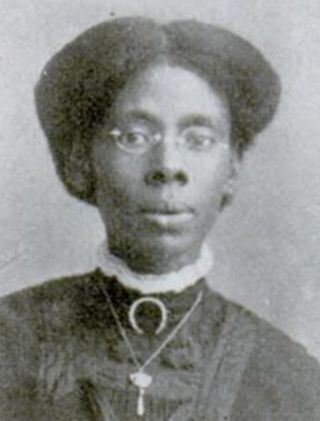
Virginia Estelle Randolph was an American educator in Henrico County, Virginia. She was named the United States' first "Jeanes Supervising Industrial Teacher" by her Superintendent of Schools, Jackson Davis, and she led a program funded by the Jeanes Foundation to upgrade vocational training throughout the U.S. South as her career progressed. Her work is widely associated with vocational education. Two schools of the Henrico County Public Schools system were named in her honor and in 2009 Randolph was posthumously honored by the Library of Virginia as one of their "Virginia Women in History" for her career and contributions to education.
The E.R. Johnstone Training and Research Center was a mental institution in Bordentown, Burlington County, New Jersey, United States, that housed people with developmental disability. Located adjacent to the Juvenile Medium Security Center in Bordentown, and listed in the National Register of Historic Places, the Edward R. Johnstone Training and Research Center opened in 1955 after the state closed the New Jersey Manual Training and Industrial School for Colored Youth as a result of the 1954 decision in the US Supreme Court case of Brown v. Board of Education. It was posthumously named in honor of Edward R. Johnstone. The building housing the females was damaged in a 1983 fire.

Richard Robert Wright Sr. was an American military officer, educator and college president, politician, civil rights advocate and banking entrepreneur. Among his many accomplishments, he founded a high school, a college, and a bank. He also founded the National Freedom Day Association in 1941.
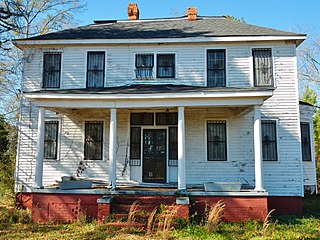
The Calhoun Colored School (1892–1945), was a private boarding and day school for Black students in Calhoun, Lowndes County, Alabama, about 28 miles (45 km) southwest of the capital of Montgomery. It was founded in 1892 by Charlotte Thorn and Mabel Dillingham, from New England, in partnership with Booker T. Washington of Tuskegee Institute, to provide education to rural black students. African Americans comprised the majority in this area, and the state had segregated facilities. Calhoun Colored School was first designed to educate rural black students according to the industrial school model common at the time.

Sumner High School is a St. Louis public high school that was the first high school for African-American students west of the Mississippi River in the United States. Together with Vashon High School, Sumner was one of only two public high schools in St. Louis City for African-American students and was segregated. Established in 1875 only after extensive lobbying by some of St. Louis' African-American residents, Sumner moved to its current location in 1908. It has historically also been known as Charles H. Sumner High School, and Sumner Stone High School.

Leonard Etienne De Paur was an American composer, choral director, and arts administrator.

The Snow Hill Normal and Industrial Institute, also known as the Colored Industrial and Literary Institute of Snow Hill, was a historic African American school in Snow Hill, Alabama. It was founded in 1893 by Dr. William James Edwards, a graduate of Tuskegee University, and began in a one-room log cabin. The school grew over time to include a campus of 27 buildings, a staff of 35, and over 400 students. The school was operated as a private school for African-American children until Dr. Edward's retirement in 1924, when it became a public school operated by the State of Alabama. The school closed in 1973, after the desegregation of the Wilcox County school system. Out of the original 27 buildings, only eight survive today. They range in architectural style from Queen Anne to Craftsman and include the founder's home, five teachers' cottages, and the library. The National Snow Hill Alumni Association and the local Snow Hill Institute supporters determined to save the remaining structures in 1980. In June 1980, Dr. Edwards' granddaughter and Snow Hill alumna Consuela Lee Moorehead reopened the school as the Springtree/Snow Hill Institute for the Performing Arts and ran after-school and summer programs for local students. The art institute continued to run until 2003 when Moorehead's declining health caused her to close down the school. The school was listed on the National Register of Historic Places on February 24, 1995.

Roscoe Conkling Bruce, Senior was an African-American educator who was known for stressing the value of practical industrial and business skills as opposed to academic disciplines. Later he administered the Dunbar Apartments housing complex in Harlem, New York City, and was editor in chief of the Harriet Tubman Publishing Company.
The Colored Teachers State Association of Texas (CTSAT) was created in 1884 to unite black educators across the state of Texas. The main goals were to create equality in the public school system under Jim Crow laws and to establish a black institution of higher education as outlined in the Texas Constitution of 1876. The organization operated for eighty-two years until its voluntary dissolution in December 1966.
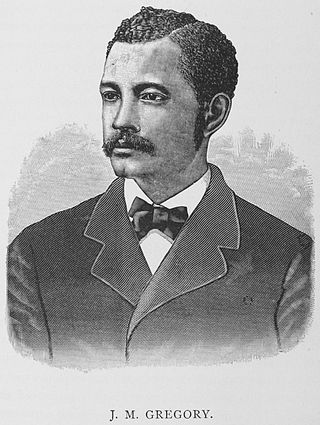
James Monroe Gregory was a Professor of Latin and Dean at Howard University. During the American Civil War, he worked in Cleveland for the education and aid of escaped slaves. He initially attended Oberlin College. He transferred to Howard and was the valedictorian of Howard's first graduating class in 1872. He then became a member of faculty, where he served until the late 1880s. During that time he was active in civil rights, particularly related to the education of African American children. He fought to desegregate Washington, D.C., schools in the early 1880s and participated in the Colored Conventions Movement and was a delegate to the 1892 Republican National Convention. In 1890, he founded the American Association of Educators of Colored Youth. In 1893, he published a biography of Frederick Douglass. In 1897, he was removed at Howard and moved to New Jersey where he became principal of Bordentown Industrial and Manual Training School.
New Jersey has some of the most segregated schools in the United States. Despite laws promoting school integration since 1881, a 2017 study by the UCLA Civil Rights Project found that New Jersey has the sixth-most segregated classrooms in the United States.
The 1924 Lincoln Lions football team was an American football team that represented Lincoln University in the Colored Intercollegiate Athletic Association (CIAA) during the 1924 college football season. In their second year under head coach Ulysses S. Young, the Lions compiled a 7–0–1 record, won the CIAA championship, shut out eight of nine opponents, and outscored all opponents by a total of 239 to 3.
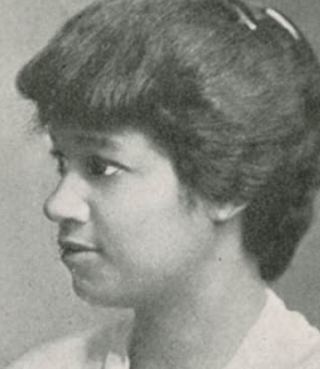
Brenda (Estelle) Ray Moryck (1892-1945) was an American writer associated with the Harlem Renaissance.

Margaret Briggs Gregory Hawkins, worked as a schoolteacher and later became known for her activism on behalf of African Americans and women. She was inducted into the Maryland Women's Hall of Fame in 2021.

